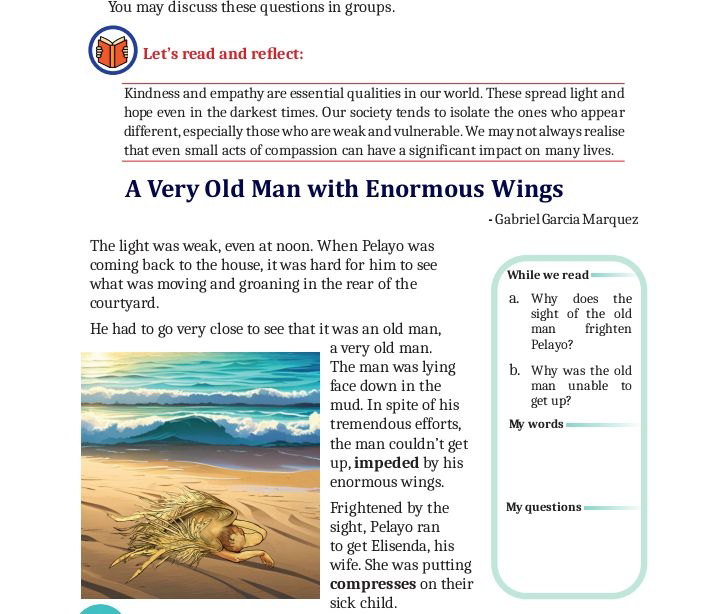Sunrise On The Hills
SUNRISE ON THE HILLS
- H W Longfellow
Activity -1 (Read and Respond)
1. Look at the expressions ‘heaven’s wide arch and ‘returning march’. What does the poet describe here? What else does it remind you of?
The poet describes here the sky and the return of the sun in the morning. It reminds me of a king returning after a long absence or even my own returning to life in the morning after the night’s sleep.
2. Comment on the expression of ‘soft gales’.
This is the poetic way of describing the early morning breeze.
3. What makes the glory of the clouds fade?
The rising sun makes the glory of the clouds fade. The mist melts away and the glory fades.
4. What are the clouds compared to?
They are compared to the army defeated in battle, ready to flee from the conqueror.
5. What picture of the valley is unveiled?
The valley is rich. The water that flows in the river gets darkened at times by the shade of the forest, but in the cascade it glistens. The bittern is flying upward spirally making noise as the dawn is softly and smoothly turning into morning.
6. How does the valley respond to the rising sun?
The valley responds to the rising sun in a lively manner. The water in the river is dashing down and currents whirl and flash. The trees of the forest are bending as if to touch the water and the silver sands of the beach of the lake. The valley is filled with the echoing noise of the wild horn, the screeching owl. Thin smoke is rising from the huts of the valley-dwellers through the thick-leaved branches as they are preparing their morning meals.
7. What message does the poet convey?
The poet says that if you are tired and are troubled with problems and sorrows that you want to forget, if you want read a book that will prevent your heart from losing hope and wake your soul up with optimism, you should go to the forest and hills. The sweet look that Nature has is not dimmed by tears of any kind.8. Are all the three stanzas of equal length? Why do you think the last stanza is short when compared to the previous stanzas?
No, the three stanzas are not of equal length. The first stanza has 18 lines, the second 12 and the third only 6-. The last stanza is short when compared to the previous stanzas because in it the poet is giving us a piece of advice. In the other two stanzas he is describing the hills, the valley, the river, the lake and the beautiful sights and sounds there. Naturally they have to be longer. Descriptions take many lines, but a piece of advice does not have to be so long.Activity – II (Read and reflect)
You may listen to the recital of the poem. Now, discuss and answer the following questions:
Comment on the musical quality of the poem.
The poem is highly musical. The rhyming couplets (arch¬march, gales-vales, light-height, etc.) give a highly’ melodious quality to the poem. The poem has fine rhythm as the stressed and unstressed syllables alternate regularly. There is alliteration that adds to The musical quality. Examples of alliteration are ‘blasted, bare’, ‘faint and far’, ‘sudden shot’, ‘from fainting’. There are also many instances of assonance which make the poem sound sweet: The poem gives a smoothing effect as it sounds so soft and sweet to the ear.
Identify the symbols used in the poem.
There are many symbols in the poem. Examples are: ‘Heaven’s wide arch’, ‘returning march’, ‘soft gales kissing the sun-clad vales’, ‘hosts in battle overthrown’, ‘shattered lance’, ‘pine, blasted, bare and cleft’, ‘the veil of cloud’, ‘woods bending with silent reach’.
How does figurative language, like the simile, make the poem effective?
Longfellow has used many figures of speech in his poem to make it effective. His figurative language includes simile, metaphor, personification and onomatopoeia, among others . He speaks of the clouds losing their glory “like hosts in battle overthrown”. This is a fine smile. There are excellent personifications in “the sun’s returning mach” and “soft gales went forth to kiss the sun-clad vales”. Metaphors can be seen in ‘Pinnacles thrusting up shattered lances’ and The dark pine blasted, bare and cleft’. There is a superb onomatopoeia in ‘the whirl and flash of currents’.
Activity – III (Appreciation)
Pick out the descriptions of sights, sounds and movements in the poem.
Does any image stand out as the most important? Why do you think so?
The image of the current whirling and flashing stands out as the most important. I think so because it represents man’s desire to explore and reach further and further.What is your overall assessment of the poem?
I think the poem is superb as it depicts some of the most alluring sights, sounds and movements of the nature. Here Longfellow can stand comparison to William Wordsworth, the high priest of Nature.
APPRECIATION OF THE POEM
Based on the above discussions, prepare an appreciation of the poem.
The poem ‘Sunrise on the Hills’ by the American poet Henry Wadsworth Longfellow is a lyric that extols the beauty of Nature and how Nature can soothe you when you are in trouble or difficulty. The poet stands upon the hills when the sky is glorious with the rays of the rising sun. The forests are brightened. Mild breezes are kissing the valleys brightened by the dawn. The clouds are under him and they are bathed in light. As the mist clears away in the rising sun, many peaks with their sharp spear-like projections appear. Soon he will see the rich valley. The river is flowing.
As the dawn breaks into morning, birds fly away chirping noisily. The poet hears the distant waters rush. He,sees the current whirl and shine in the light. The lake is blue with a beach of sliver sand and near it the thick forest is bending as if to reach and kiss the lake. Over the valley the gentle and melodious sound of the village bell is echoing on the hills. The thin smoke starts coming out from the wooded valley through the thick leaved branches, from the huts of the people living in the valley.
The poet says that if you are tired and are troubled with problems and sorrows that you want to forget, if you want to read a book that will prevent your heart from losing hope and wake up your soul with optimism, you should go to the forest and hills. The sweet look that Nature has is not dimmed by tears of any kind.
The poet has used exquisite phrases to depict the sights, sounds and movements of the Nature. He has used many figures of speech to drive his points home. The message is clear. Go to nature to forget your sorrows and troubles. A glorious sunrise can life even the gloomiest person with hope and optimism.
The poem is full of visual, auditory and kinaesthetic imagery. In this poem Longfellow stands comparison to the greatest Nature Poet, William Wordsworth. Wordsworth is called the High Priest of Nature. The world today is full of problems and one reason for them is our contempt and disregard for nature. We destroy the beauty of nature. Now we have concrete jungles instead of jungles full of trees, wild animals and birds. Longfellow wants us to return to Nature and enjoy its superb sights, melodious sounds and exquisite movements.
Read and Discuss :
The modes of travel differ. Some may result in more intense and interesting experience.
Christ Foster is a 48-year teacher from Southern California. He has completed the first part of a solo motor cycle journey around the world, travelling 13,343 miles. He has gone across 3 continents, and eleven countries. By travelling on his motorcycle he wants to get close to everything – the weather, the smells, the sights, and the people. His main motivation is to get to know the various countries and the customs there.
Christ Foster is a 48-year teacher from Southern California. He has completed the first part of a solo motor cycle journey around the world, travelling 13,343 miles. He has gone across 3 continents, and eleven countries. By travelling on his motorcycle he wants to get close to everything – the weather, the smells, the sights, and the people. His main motivation is to get to know the various countries and the customs there.
What does the travel experience of this teacher tell us?
It tells us that he is a very adventurous person. He wants to have a first-hand experience of everything – the weather, the smells, the sights, and the people of different countries. He wants to learn about the different customs people have in the countries he visits.
What do you think interests him more: where to travel dr how to travel?
I think where to travel interests him more as one of his main motivations is to get a first-hand knowledge of various countries and their customs.



Comments
Post a Comment
Please share your feedback and questions